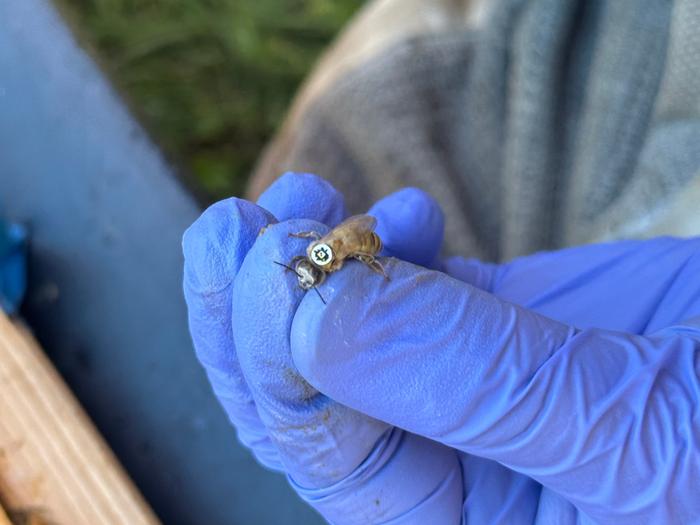
In a groundbreaking initiative that marries ecology with technology, researchers from Penn State University have embarked on an innovative study that utilizes tiny QR codes to track honey bees as they venture away from their hives. This remarkable project highlights the intersection of entomology and electrical engineering, employing an automated imaging system designed to monitor the time bees spend foraging for food. This study is pivotal in shedding light on a long-standing question in ecological study: the distance honey bees truly travel in search of nectar and pollen.
Equipped with minuscule fiducial tags, which are essentially QR codes smaller than a human fingernail, several hundred bees in rural Pennsylvania and New York have been monitored through specialized tracking equipment. This method allows the team of researchers to gain insights into the foraging behavior of honey bees, an essential aspect of maintaining healthy ecosystems. The study focuses on understanding how long these industrious insects stay away from their hives, with initial observations revealing that the majority of foraging trips last only a few minutes. However, some unexpectedly extend beyond two hours, prompting curiosity regarding the factors influencing these anomalies.
The research team, led by Margarita López-Uribe, an associate professor of entomology, has noted the profound implications this technology presents for the field of organic beekeeping. Since honey bees can travel considerable distances—up to ten kilometers or more—they frequently face challenges related to pesticides and pollution. By understanding their actual foraging distances, organic beekeeping regulations can be refined, potentially alleviating some burdens an organic certification imposes on beekeepers. The collaboration between entomologists and engineers underscores the necessity of interdisciplinary approaches in addressing complex biological questions.
This innovative study stands out as the first of its kind, employing technology that can monitor honey bees unobtrusively in real-world conditions rather than controlled laboratory settings. The engineers involved engineered a solar-powered automated imaging system that not only tracks the bees but does so in a way that is cost-effective and open-source. This accessibility ensures that other researchers globally can replicate and build upon the work being done at Penn State, signaling a new era in ecological research capabilities.
The phenomenon of the “waggle dance,” a well-known behavior used by honey bees to communicate the location of food sources, has historically been the primary method for determining foraging distances. However, the significant limitation of this method is its reliance on human observation, which is inherently flawed by time constraints and subjective interpretation. By replacing or augmenting these observations with high-frequency digital monitoring, the researchers hope to achieve a more comprehensive understanding of bee foraging patterns.
Throughout the spring and summer seasons of the study, 32,000 bees were tagged and monitored. This involved meticulous fieldwork, where researchers collected data on when bees left and returned to their hives. The cameras recorded each bee’s movements in real-time, allowing researchers to analyze variances in foraging behaviors, including trip durations and the impact of environmental factors on foraging efficiency. The findings thus far suggest that bees may indeed be foraging for longer periods than previously understood, revealing previously unrecognized complexities in their foraging behavior.
Challenges arose during the initial stages of the project, particularly with bees that lingered at the hive entrance, which skewed the data. Thanks to careful programming, researchers could filter out this outlier data, ensuring their observations remained focused on meaningful foraging trips. This level of detail represents a significant leap forward in how scientists study bee behavior, paving the way for future research projects focusing on other species and vital ecological interactions.
As the research progresses, collaborations are also forming with other institutions, including Virginia Tech, to correlate the duration of foraging trips with the bees’ decoded waggle dances. This multifaceted approach promises to generate new insights that could revolutionize how we perceive the foraging behavior of honey bees and their ecological roles. It emphasizes the potential for technology and traditional biological research to complement each other harmoniously, reestablishing the foundation upon which entomological studies are built.
Importantly, the practical implications of this technology extend beyond mere academic curiosity. Enhancing our understanding of honey bee foraging has a direct impact on agriculture, food production, and biodiversity conservation. As pollinators, honey bees play an essential role in food systems; ensuring they thrive is crucial for maintaining healthy ecosystems. By offering an innovative method to monitor and analyze their behavior, this study positions itself at the forefront of beekeeping and agricultural research.
Furthermore, the researchers aim to democratize access to this new technology with plans for workshops designed for both scientists and beekeepers. Engaging a broader audience will facilitate the widespread application of improved monitoring techniques and ensure that the data generated can be utilized to inform sustainable practices in beekeeping, ultimately benefiting the environment.
In conclusion, the fusion of technology and environmental science represented in this research exemplifies the immense potential for innovative methods to transform our understanding of ecological systems. By leveraging advancements in technology, researchers are breaking barriers in traditional methodologies, allowing for a more holistic view of the intricate behaviors of honey bees and, by extension, their critical role in our ecosystems. As additional findings emerge, this groundbreaking study could well signal a significant shift in environmental monitoring practices and inspire future generations of researchers.
Subject of Research: Honey bee foraging behavior
Article Title: Automated entrance monitoring to investigate honey bee foraging trips using open-source wireless platform and fiducial tags
News Publication Date: 28-Nov-2024
Web References: DOI link
References: Not provided
Image Credits: Provided by Margarita López-Uribe, Robyn Underwood, Julio Urbina, Diego Penaloza-Aponte, and team
Keywords
Life sciences, Organismal biology, Insects, Beekeeping, Environmental monitoring, Innovation in research.
Tags: bee ecosystem healthecological impact of honey beesentomology and electrical engineeringhoney bee foraging behaviorinnovative tracking methods in entomologyminiature QR codes for researchmonitoring bee nectar and pollen searchPenn State University bee studyQR code technology in ecologyrural Pennsylvania bee researchtracking honey bee movementunderstanding bee foraging patterns





